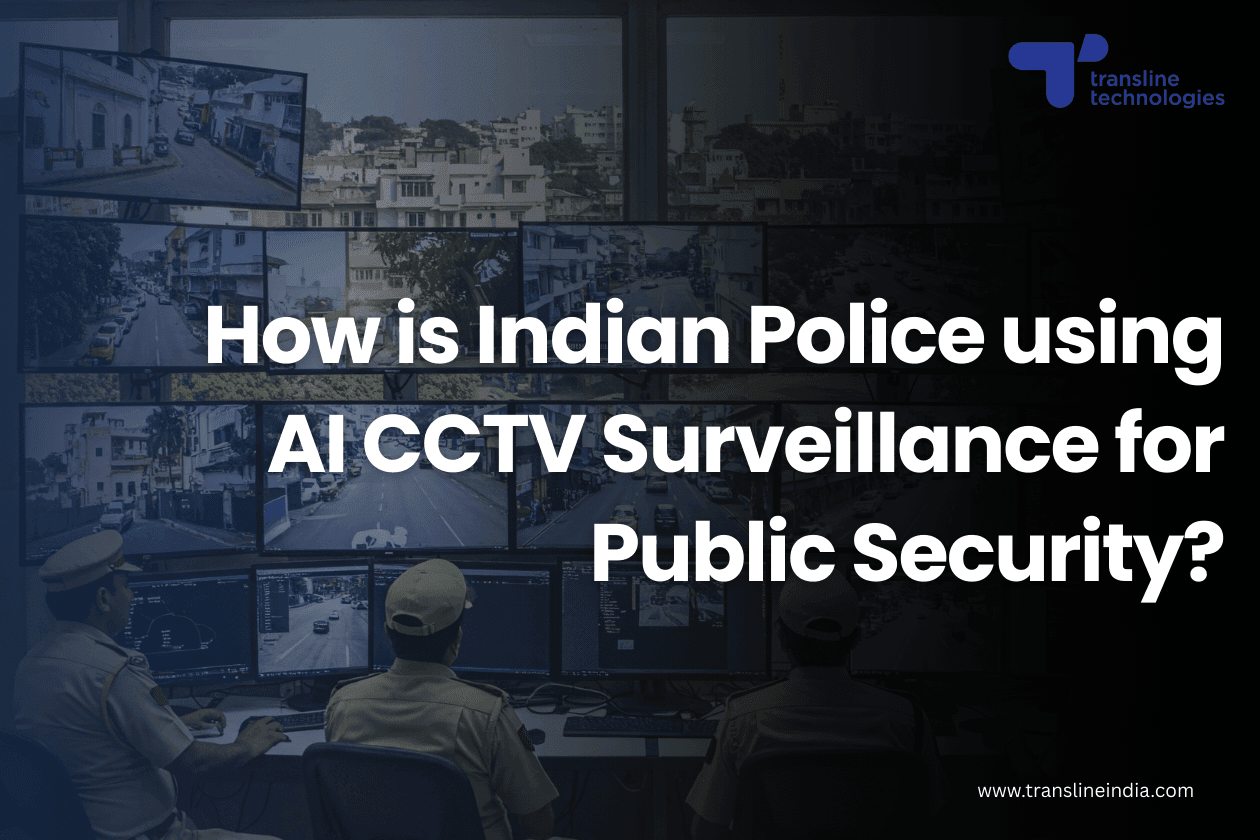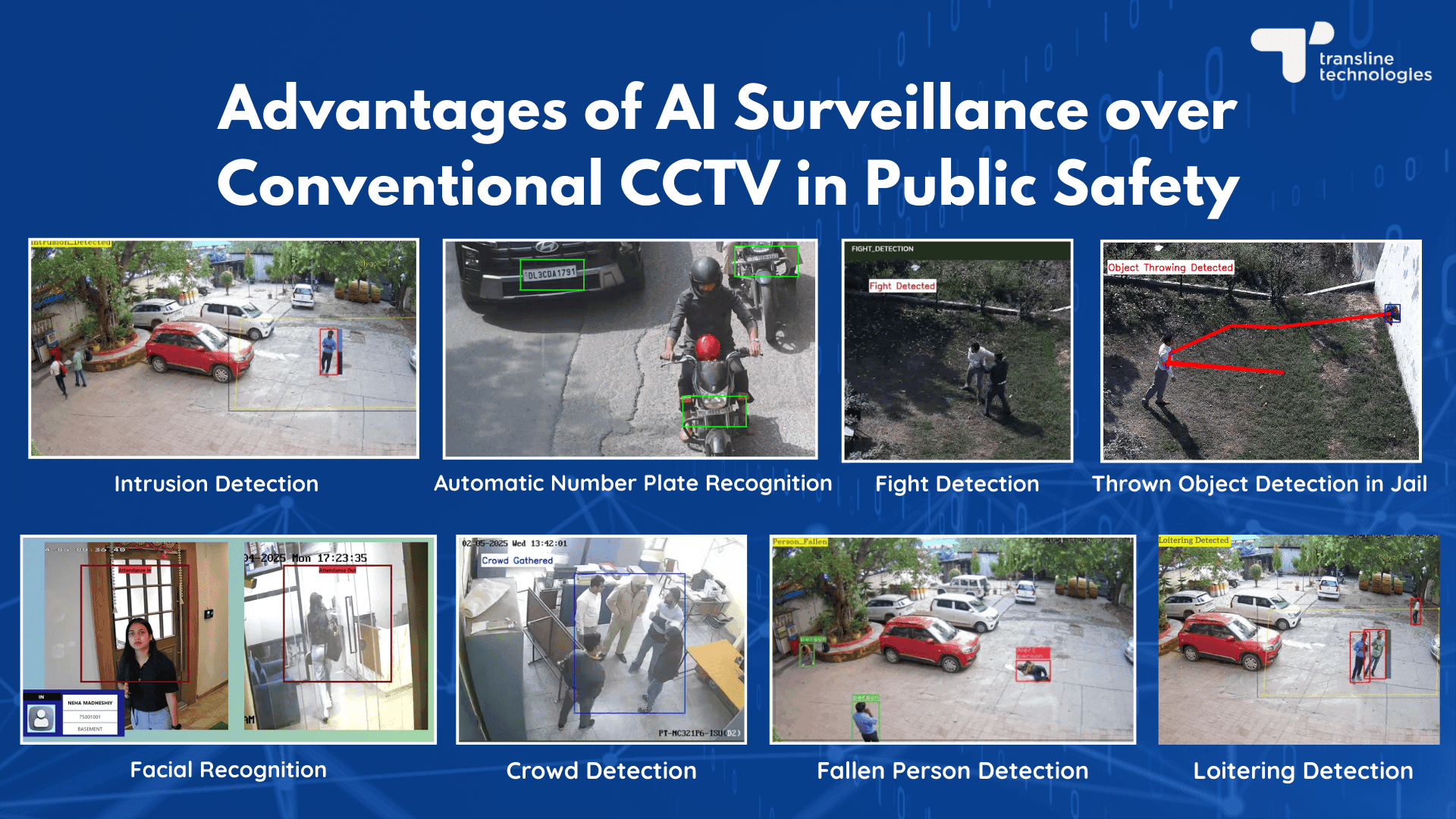
With a sporadic rise in concerns stemming from urbanisation and globalisation, crime rates have seen a dramatic increase. For over a decade, the Indian security system has relied on police forces to uphold laws, prevent and investigate crimes, and maintain the safety and security of citizens. Traditionally, police forces utilised paperwork and basic CCTV footage networks to investigate crimes. Over time, modern surveillance systems powered by Artificial Intelligence have started replacing these methods. These AI-driven systems are not just recording events but also providing real-time analysis, helping prevent crimes even before they take place. In this blog, you’ll learn how AI CCTV surveillance is being utilised to enhance public security in India.
Public Safety in India
Public safety refers to the measures taken to protect public security and maintain peace. These measures are often designed collectively, keeping the general public in mind. In India, public safety is given significant importance to prevent rising crime rates and mitigate their consequences. It is not only essential for creating a safe environment and maintaining order but also for ensuring the overall well-being of citizens by empowering and uplifting them.
India has a set of laws and regulations specifically designed to protect public safety and maintain peace. The police department plays a vital role in ensuring public safety. However, beyond the police, several government bodies are also accountable for maintaining law and order in the country. These include the Central Government through the Ministry of Home Affairs, the Economic Offences Wing (EOW), the Crime Investigation Department (CID), Central Police Organisations, Central Armed Police Forces (CAPF), State Police Forces, National Disaster Management Authority (NDMA), the Special Protection Group (SPG), and the National Security Guard (NSG). These bodies work together to ensure different aspects of public safety and security. Moreover, the Indian system has multiple legal frameworks that help navigate the safety concerns.
Challenges to Internal Security and Public Safety in India
India faces multifaceted challenges to its internal security and overall public security, stemming from both conventional threats, which have plagued the nation for years, and emerging threats in the digital and phygital spaces. Urbanisation, rapid population growth, and socio-political tensions with neighbouring nations and internal extremist groups have intensified issues like crime, terrorism, social unrest, and cybersecurity threats. Communal violence, insurgencies in remote areas of some States, and crime syndicates continue to perturb law enforcement agencies. Additionally, lower police-to-citizen ratio (compared to Western developed countries) and outdated vigilance infrastructure hinder rapid response and proactive crime prevention.
In this dynamic landscape, public spaces are especially vulnerable to incidents ranging from thefts to terror attacks. Real-time monitoring and situational awareness are often lacking, making preventive policing difficult. The complexity of these challenges demands not only manpower but also intelligent systems capable of swift detection and analysis.
This is where Artificial Intelligence driven police surveillance is beginning to play a transformative role. With capabilities such as facial recognition, human behavior analysis, and automated alert systems, AI-powered police surveillance enhances the ability of police forces to preempt untoward incidents and respond with greater agility. However, the effectiveness of such technologies depends on the ease of integration with existing systems, data privacy safeguards, and trained tech-savvy personnel. As internal security threats evolve, so must the tools the police use to counter them. AI police CCTV cameras are emerging as key assets in bolstering public safety across India’s diverse and densely populated urban environments.
How does the Police Leverage CCTV Surveillance for Public Security?
Collection of evidence for post-crime investigation, assuring citizens with a feeling of safety and security, observing traffic congestions and manually redirecting traffic movements, Investigation of kidnapping & missing cases. Positioned in strategic locations such as streets, intersections, and public buildings, analog CCTV cameras provide real-time footage that officers can review manually. Although these systems lack advanced features like facial recognition for automated alerts, their presence alone acts as a preventive measure against crime. During investigations, recorded footage from analog CCTVs can be vital for reconstructing events, verifying witness statements, or tracing the movements of suspects. Moreover, patrol units may be guided more effectively by coordinating with control rooms monitoring the live feeds. Despite technological limitations, analog CCTV remains a foundational tool in traditional policing strategies.
Advantages of AI CCTV over Conventional CCTV in Public Safety
Overcrowding, Loitering and Vandalism Detection
Indian police forces are increasingly leveraging AI-powered CCTV surveillance to enhance public safety by detecting overcrowding, loitering, and vandalism. In Chennai, the Greater Chennai Police have deployed over 5,000 AI-enabled CCTV cameras under the Safe City Project. These cameras, integrated with an AI-based software system, offer analytics features coupled with alerts to facilitate immediate action on crime incidents, including vandalism and loitering. Similarly, the Bangalore City Police utilize AI-based video analytics for real-time monitoring of crowded areas, enabling swift responses to potential threats. In Ayodhya, during significant events like the 'pran prathishtha' ceremony at Sri Ram Mandir, the Uttar Pradesh Police employed AI-powered CCTV cameras to monitor large gatherings, ensuring effective crowd management and public security. These advancements in police CCTV surveillance underscore a nationwide shift towards proactive policing, where AI-enhanced systems play a crucial role in maintaining public safety and order.
Facial Recognition for Criminal Identification among Crowd
The police departments of many States have started utilising AI-powered CCTV cameras, equipped with facial recognition technology, to enhance public safety by identifying criminals within crowds. In Delhi, law enforcement agencies have adopted such systems to match faces captured on surveillance footage with existing criminal databases, facilitating the swift identification and apprehension of suspects. For instance, the Delhi Police employed facial recognition technology to solve a robbery case involving ₹80 lakh, successfully identifying and arresting the culprits by analyzing footage from approximately 500 CCTV cameras.
Similarly, the Coimbatore City Police in Tamil Nadu have implemented AI-based facial recognition systems integrated with the Crime and Criminal Tracking Network and Systems (CCTNS) to bolster police security. These systems automatically alert control rooms upon detecting individuals with criminal records, thereby streamlining the process of suspect identification.
In Rajasthan, police have incorporated facial recognition features into their mobile application, enabling officers at checkposts to photograph suspects and instantly verify their identities against a centralized database.
These advancements in police surveillance underscore a nationwide shift towards proactive policing, where AI-enhanced systems play a crucial role in maintaining public security and order.
ANPR and Traffic Violation Detection
From catching red-light jumpers to tracing stolen vehicles, Indian police forces are leveraging AI-powered CCTV cameras to redefine public safety. These police surveillance systems use Automatic Number Plate Recognition (ANPR) to automatically detect traffic violations like overspeeding, helmetless riding, and seatbelt non-compliance. In cities like Bengaluru and Chandigarh, police station CCTV surveillance has drastically reduced manual monitoring, issuing lakhs of challans through AI alone. By integrating smart police security with real-time alerts, these police CCTV cameras are not just enforcing rules—they’re transforming traffic management across India.
Gun and Weapon Detection
Gun detection is no longer reliant on human vigilance alone. Indian police forces are now equipping CCTV networks with AI-powered systems capable of identifying weapons in real time. Using advanced object detection algorithms – such as convolutional neural networks (CNNs) and models like YOLO (You Only Look Once) – these systems scan video feeds to distinguish firearms from innocuous objects with high accuracy. When a weapon is detected, an automated alert is triggered, allowing officers to act before violence unfolds.
Delhi Police have deployed thousands of AI-enabled police surveillance cameras with real-time analytics during high-risk events, while UP Police have integrated similar systems into their police station CCTV surveillance networks to monitor sensitive areas. These AI tools don’t just flag visible weapons; they also learn from behavioral patterns—like sudden drawing motions—enhancing threat prediction. By embedding artificial intelligence into police security cameras, law enforcement is now better equipped to safeguard public safety through faster, smarter interventions.
Intrusion and Object Throwing Detection in Prisons
With rising concerns about prison safety, Indian police forces are turning to AI-powered CCTV surveillance systems to keep correctional facilities more secure. These smart systems are proving vital in spotting intrusions and stopping object-throwing incidents—issues that can quickly escalate if left unchecked.
AI algorithms help monitor movements in real time, flagging any attempts to enter restricted zones by comparing individual positions with pre-set boundaries. One major concern is the smuggling of contraband through thrown objects—either by inmates or outsiders. AI cameras can detect these rapid, unusual motions near jail walls and instantly alert prison staff.
In Amritsar, police are installing AI-based surveillance systems along with physical barriers to stop such activities. Delhi, Uttar Pradesh and Karnataka have also adopted similar technologies in high-security jails to strengthen monitoring efforts.
These police CCTV cameras improve public safety by reducing blind spots, enabling faster response times, and easing the burden on manual surveillance. They offer detailed footage analysis and proactive alerts, helping jail authorities stay one step ahead.
As police departments across the country continue modernizing prison infrastructure, AI surveillance is quickly becoming a core part of their strategy. By making facilities safer and more controlled, this technology is playing a growing role in India's push toward smarter public security systems.

Crowd Gathering and Fighting Prevention among Inmates in Prisons
When inmates gather in groups, it can indicate potential trouble, including planned violence or unrest. AI-powered police CCTV surveillance cameras actively track whenever a certain number of inmates gather in specific areas, triggering alerts to police officers. The system can also track the duration and behavior of the crowd to assess the level of risk, enabling timely intervention. Fights or aggressive behavior between inmates can escalate quickly, leading to injuries or damage to property. AI police security camera systems use pattern recognition and movement analysis to detect sudden spikes in aggressive behaviour (which is different from the normal interactions and activity) and send real-time alerts to notify security personnel.
Fallen Person Detection
AI-powered Police Cameras can detect fallen persons in real-time and trigger alerts to the concerned personnel for relief services. This is becoming a very popular application of police surveillance cameras nowadays, especially in crowded urban areas and public transportation hubs. The algorithm analyses certain human gestures and orientations to identify if the person is standing or laying on the ground, and combines it with temporal attributes to identify if the person has fallen.
Hindrances in Implementing AI CCTV Surveillance for Public Security
Privacy Concerns
In India, the deployment of police CCTV cameras has sparked significant privacy concerns, especially amid recent protests. For instance, during the Mahakumbh 2025 in Prayagraj, over 2,700 CCTV cameras, including AI-powered ones, were installed to monitor crowds and manage traffic. While intended for safety, such extensive surveillance has raised alarms about mass data collection and potential misuse.
Similarly, in Lucknow, the police introduced AI-based cameras capable of detecting women's facial expressions to identify distress. This initiative, part of the state's Smart City project, faced backlash from activists who viewed it as an infringement on privacy and a tool for unwarranted surveillance.
The use of facial recognition technology (FRT) during public events has also been contentious. In December 2019, Delhi Police employed FRT to screen crowds at a political rally, leading to accusations from digital rights groups that such mass surveillance is illegal and unconstitutional.
These incidents highlight how the right balance between enhancing public safety and safeguarding individual privacy rights needs to be maintained while installing police CCTV surveillance cameras, while adhering to the compliance norms.
Low Initial Acceptance
In India, due to the skewed age distribution in the police forces, a large percentage of the police officials are not so tech-savvy, and this leads to a very slow adoption and initial acceptable rate of police CCTV cameras. Even after the installation of cameras and set-up of control rooms, often these are not properly monitored, or troubleshooting of minor issues cannot be done internally, thereby making the systems dysfunctional. However, AI police CCTV cameras significantly reduce the requirement for tech knowledge (as alerts are delivered in a convenient format on a unified dashboard, requiring minimal human intervention). Plus AI-powered network health monitoring systems like CheckCam allow police officers to readily identify any camera or network downtime, with precise geo-location of the fault.
Setup Costs and Operational Costs
The high initial setup costs of police surveillance systems poses the biggest hindrance for their installation in public safety applications. Police departments have to incur heavy costs of the cameras, associated network hardware such as switches and routers, cables and their armoured protection, hard disks and storage equipment, power backup equipment, server OS, other software and hardware systems. This becomes a burden on the annual budget of the police department. Operational costs of the police surveillance systems further stress the budget commitments.
Power and Internet Bandwidth Disruptions
Though power backup devices are usually installed in the control room and with the switches for police CCTV camera systems, longer power cuts (which are frequent in the tier-II cities) disrupt the operations of these CCTV systems. This results in missing footage and lack of surveillance, making the areas under vigilance vulnerable to generic risks. Internet bandwidth requirements for CCTV systems are also very high, though intelligent storage compression solutions like CAMSTORE significantly reduce the Internet bandwidth requirements.
Driving the Way Ahead for Police Surveillance
At Transline Technologies, we are deeply committed to empowering Indian police forces with intelligent, future-ready surveillance solutions. By integrating AI with police CCTV camera systems, we help law enforcement agencies enhance situational awareness, enable rapid response, and ensure the safety of citizens with greater precision and efficiency. As policing evolves in the digital age, our CCTV surveillance systems, powered by cutting-edge technologies, stand at the forefront of this transformation—making cities smarter and communities safer.
Connect with Us today to explore how our AI-powered surveillance solutions can support your mission of public security and operational excellence.



